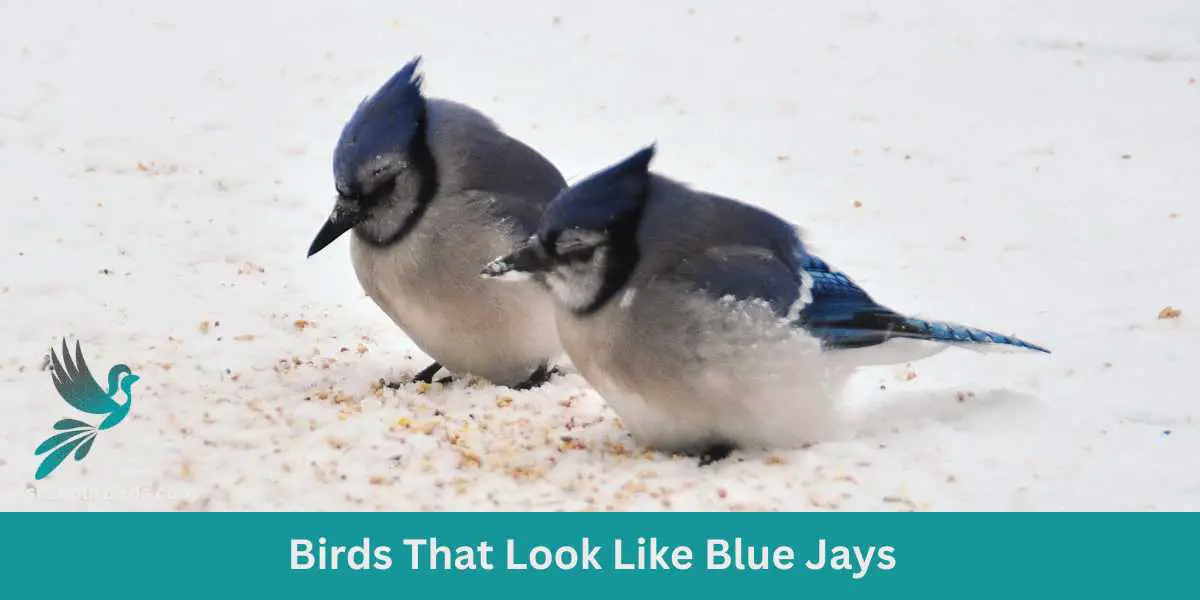The Blue Jay (Cyanocitta cristata) is a striking bird known for its vibrant blue plumage and distinct crest. While there are no birds that perfectly mimic the Blue Jay’s appearance, several bird species share similar features or colorations.
The Steller’s Jay (Cyanocitta stelleri) closely resembles the Blue Jay with its blue feathers, black head, and crest, but has a darker appearance overall. The Florida Scrub-Jay (Aphelocoma coerulescens) is another species that exhibits blue plumage and a crest, although it has a more subdued coloration compared to the Blue Jay.
Other birds that may resemble Blue Jays include the Azure Jay, the Green Jay, the Black-crested Jay, the Pinyon Jay, the California Scrub-Jay, the Mexican Jay, the Island Scrub-Jay, and the Woodhouse’s Scrub-Jay, which all have variations of blue plumage or crest-like features. While these birds share certain similarities with the Blue Jay, each species has its own unique characteristics and habitats.
List of Birds that look like blue jays
Mountain Bluebird
Indigo Bunting
Steller’s Jay
California Scrub-Jay
Canada Jay
Green Jay
Florida Scrub-Jay
Woodhouse’s Scrub-Jay
Pinyon Jay
Mexican Jay
Key Takeaways:
While no birds perfectly mimic the Blue Jay’s appearance, several species share similar features or colorations.
The Steller’s Jay closely resembles the Blue Jay with its blue feathers, black head, and crest, but has a darker appearance overall.
The Florida Scrub-Jay exhibits blue plumage and a crest but has a more subdued coloration compared to the Blue Jay.
Other birds such as the Azure Jay, Green Jay, Black-crested Jay, Pinyon Jay, California Scrub-Jay, Mexican Jay, Island Scrub-Jay, and Woodhouse’s Scrub-Jay may also resemble Blue Jays to some extent.
Mountain Bluebird


| Feature | Measurement |
|---|---|
| Scientific Name | Sialia currucoides |
| Length | 6.1–7.1 in |
| Wingspan | 11.0-14.2 in |
| Weight | 24–37 g |
The Mountain Bluebird is a small bird found in open grasslands and rocky mountains of North America. It is known for its stunning blue plumage, which is particularly vibrant in males. Females, on the other hand, have a more subdued blue coloration with hints of gray. These birds have slender bodies and a slightly curved bill, adapted for catching insects on the wing.
Mountain Bluebirds are insectivores, feeding primarily on insects such as beetles, grasshoppers, and spiders. They are skilled aerial hunters, capable of capturing their prey in mid-flight. During breeding season, these birds build their nests in tree cavities or man-made nest boxes, where females lay a clutch of eggs. The male bluebird actively participates in nest-building and provides food for the female during incubation.
Indigo Bunting
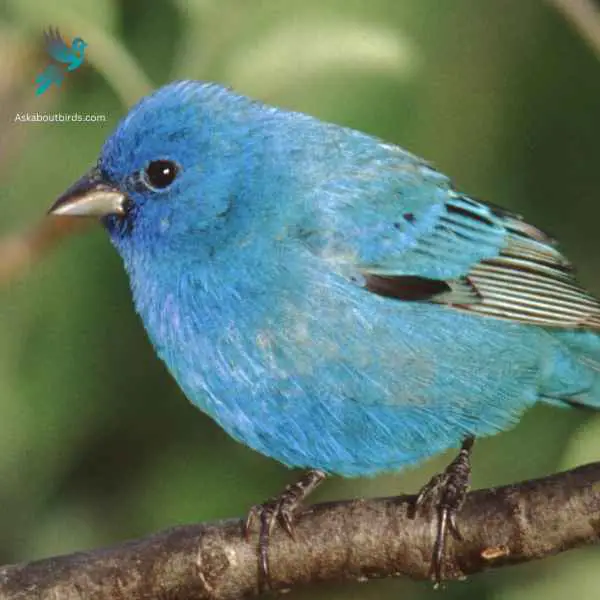

| Feature | Measurement |
|---|---|
| Scientific Name | Passerina cyanea |
| Length | 4.5–5.1 in |
| Wingspan | 7.1–9.1 in |
| Weight | 11.2–21.4 g |
The Indigo Bunting is a strikingly vibrant songbird, often hailed for its brilliant blue plumage and melodic song that graces woodlands and meadows during the warmer months.
Appearance: Males are renowned for their bright indigo blue feathers, which can appear darker in certain lights. Females and juveniles, on the other hand, are brown with subtle hints of blue on their wings and tail. The species lacks the vibrant streaking or spotting commonly found in many other songbirds.
Diet: Indigo Buntings primarily subsist on seeds, especially during non-breeding seasons. During the breeding season, they also consume a variety of insects such as beetles, caterpillars, and spiders, providing essential protein for their growing chicks.
Reproduction: Indigo Buntings build their nests close to the ground in shrubs or low tree branches. These nests, crafted meticulously with grasses and other plant materials, cradle clutches of typically 3 to 4 eggs. After hatching, the young are fed by both parents until they’re ready to fledge.
Steller’s Jay

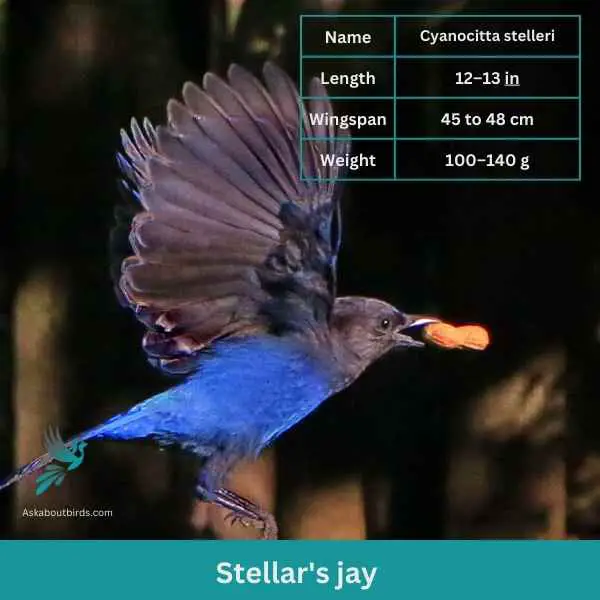
| Feature | Measurement |
|---|---|
| Scientific Name | Cyanocitta stelleri |
| Length | 12–13 in |
| Wingspan | 45 to 48 cm |
| Weight | 45 to 48 cm |
The Steller’s Jay is a charismatic and easily recognizable bird found mainly in the coniferous forests of the western North America, known for its bold behavior and loud, varied calls.
Appearance: The Steller’s Jay has a striking color contrast with a deep blue body and wings and a blackish head and upper body. One of its most distinguishing features is the tall, dark crest on its head, which can be raised or lowered depending on the bird’s mood. Its eyes are dark and its beak is strong and black.
Diet: The Steller’s Jay is omnivorous. It feeds on a wide range of items, from seeds, nuts, and berries to insects and small animals. It’s also known to raid campsites and picnics, often scavenging for human food.
Reproduction: Steller’s Jays form monogamous pairs that often remain together for several years. They typically build their nests in coniferous trees, made from twigs, moss, and other plant materials. The female lays a clutch of 2 to 6 eggs, which are usually pale green or blue with brown spots.
California Scrub-Jay

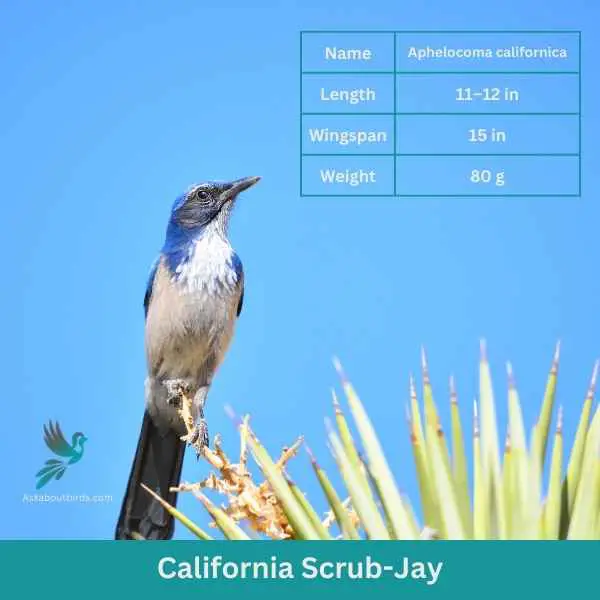
| Feature | Measurement |
|---|---|
| Scientific Name | Aphelocoma californica |
| Length | 11–12 in |
| Wingspan | 15 in |
| Weight | 80 g |
The California Scrub-Jay is a vivacious bird known for its intelligence and striking appearance, predominantly found in the chaparral, oak woodlands, and residential areas of California and parts of the Pacific Northwest.
Appearance: This jay boasts a vivid blue head, wings, and tail, complemented by a pronounced white eyebrow, a white underbelly, and a soft gray back. A distinguishing feature is the blue necklace or band across its throat and chest, which differentiates it from some other jay species.
Diet: California Scrub-Jays are omnivorous. Their diet consists of insects, fruits, seeds, and nuts, with acorns being a particular favorite. They, like their Floridian counterparts, will also cache acorns and other foods in the ground to consume later.
Reproduction: The California Scrub-Jay forms monogamous pairs. The nests, usually built between 1 to 3 meters off the ground in trees or shrubs, are constructed using twigs and lined with finer materials like hair or plant fibers. The female lays a clutch of 3 to 6 eggs that are greenish or bluish and speckled with brown.
Canada Jay
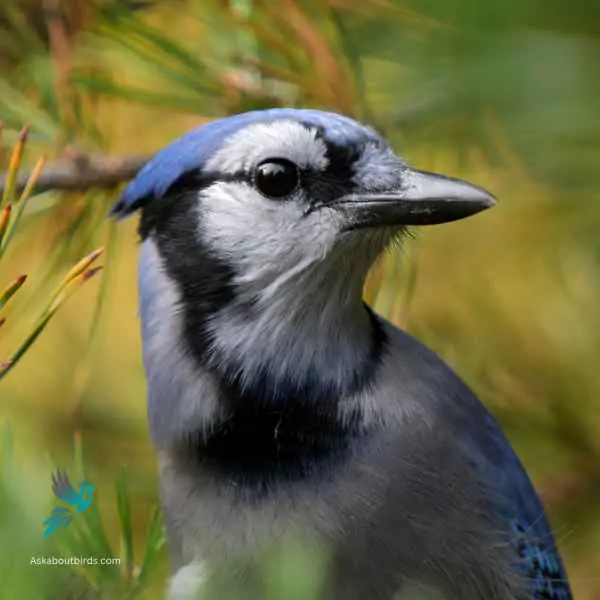

| Feature | Measurement |
|---|---|
| Scientific Name | Perisoreus canadensis |
| Length | 9.8 and 13.0 in |
| Wingspan | 18 in |
| Weight | 65 to 70 g |
Canada Jays are known for their intelligence and resourcefulness. They are omnivores and will eat a variety of foods, including insects, berries, and small rodents. They are also known for their habit of caching food for later use, often storing it in tree bark or crevices.
In the winter, they will even bury their food in the snow to keep it fresh. Canada Jays are monogamous and mate for life, building large nests made of twigs and moss. They are a hardy bird that is able to survive in harsh winter climates, making them a beloved symbol of the Canadian wilderness.
Green Jay
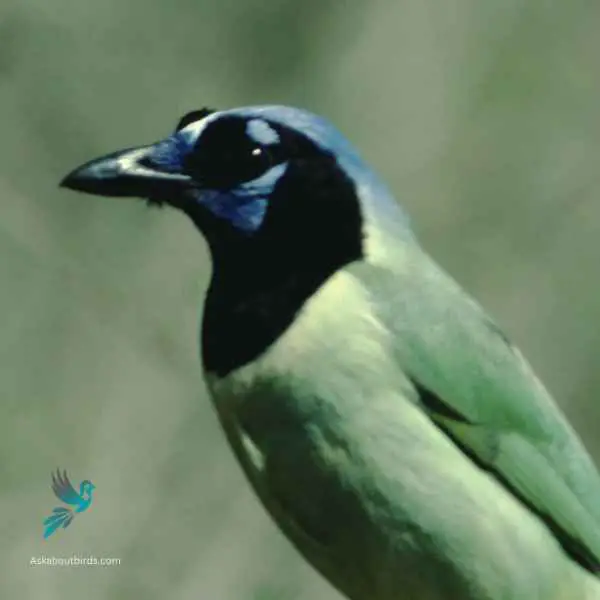

| Feature | Measurement |
|---|---|
| Scientific Name | Cyanocorax luxuosus |
| Length | 11 in |
| Wingspan | 15 in |
| Weight | 66 to 110 g |
The Green Jay is a brightly colored bird native to Central and South America. It is easily recognized by its green, blue, and yellow feathers, with a black mask around its eyes. These birds are social creatures, often seen in groups of up to 12 individuals. They are also known for their loud and varied vocalizations, including calls that sound like a cat’s meow or a dog’s bark.
Green Jays are omnivorous, feeding on a variety of foods such as insects, fruits, and seeds. They are also known to steal food from other birds. These birds are found in a range of habitats, from forests and woodlands to scrublands and gardens. Despite their striking appearance, Green Jays are not commonly kept as pets due to their specialized dietary needs and high level of intelligence.The Canada Jay, also known as the Gray Jay, is a medium-sized bird found in the boreal forests of North America. They have a distinctive gray head, neck and upper body, with a white chest and black tail feathers. Their wings are rounded and short, allowing them to maneuver easily through dense trees.
Florida Scrub-Jay
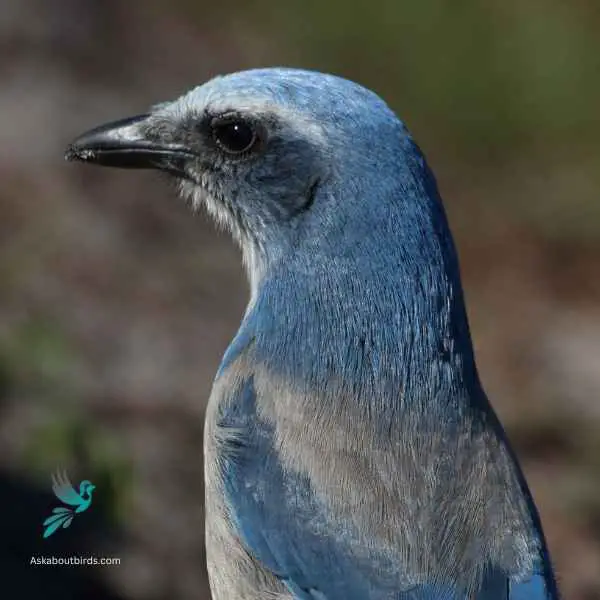
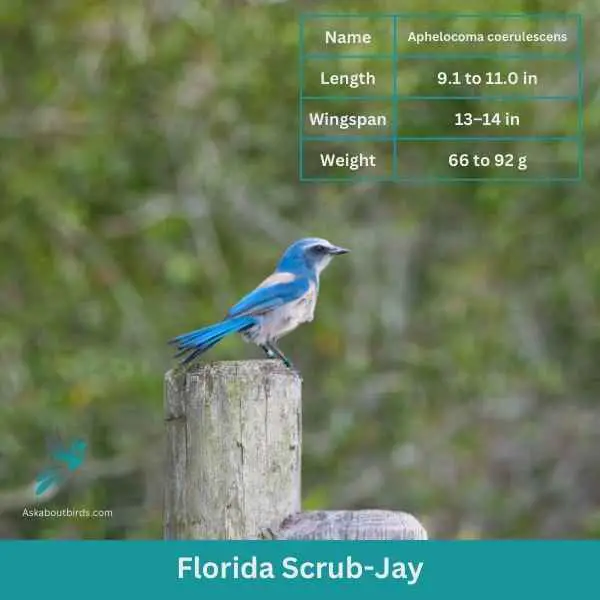
| Feature | Measurement |
|---|---|
| Scientific Name | Aphelocoma coerulescens |
| Length | 9.1 to 11.0 in |
| Wingspan | 13–14 in |
| Weight | 66 to 92 g |
The Florida Scrub-Jay is a striking, cooperative-breeding bird endemic to the sandy scrublands of Florida. It stands out as the only species of bird restricted entirely to the state of Florida.
Appearance: The Florida Scrub-Jay exhibits a bright blue head, wings, and tail, contrasting with its pale gray underbelly and nape. Its stout bill, legs, and eyes are black. Unlike other jays, it lacks a crest on its head.
Diet: Primarily, the diet of the Florida Scrub-Jay consists of a variety of insects and small animals, seeds, and especially acorns. They have a unique behavior of storing thousands of acorns, burying them in the ground as a food reserve for the lean winter months.
Reproduction: These jays are monogamous and often form family groups. They typically nest in shrubs or low trees. The nest, built primarily by the female, is made of twigs and lined with fine plant material. The female lays a clutch of 3 to 4 eggs, which are pale greenish or bluish and spotted with brown.
Woodhouse’s Scrub-Jay
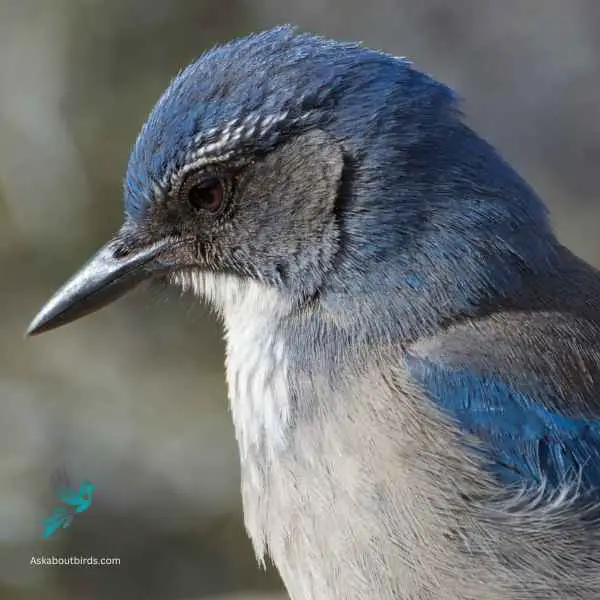
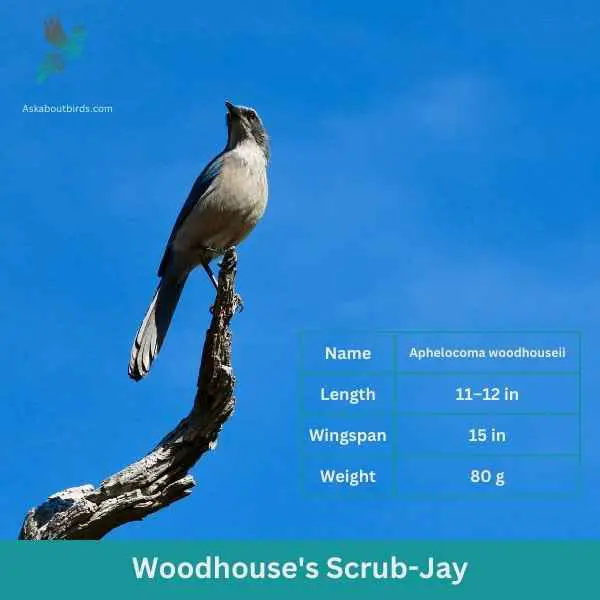
| Feature | Measurement |
|---|---|
| Scientific Name | Aphelocoma woodhouseii |
| Length | 11–12 in |
| Wingspan | 15 in |
| Weight | 80 g |
Woodhouse’s Scrub-Jay is a medium-sized bird that is found in the western part of North America. It has a blue-gray head, wings, and tail, with a brownish-gray back and a white belly. The bird’s bill is black and its eyes are dark. Woodhouse’s Scrub-Jay is known for its loud and harsh calls, which it uses to communicate with other birds in its flock.
This bird is commonly found in arid and semi-arid habitats, such as deserts, scrublands, and oak woodlands. It is an omnivore, feeding on a variety of insects, seeds, fruits, and small animals. Woodhouse’s Scrub-Jay is known for its intelligence and ability to cache food for later use. It is also a territorial bird, defending its territory from other birds and animals. Despite being a common bird, Woodhouse’s Scrub-Jay is threatened by habitat loss and fragmentation, making conservation efforts important for its survival.
Pinyon Jay
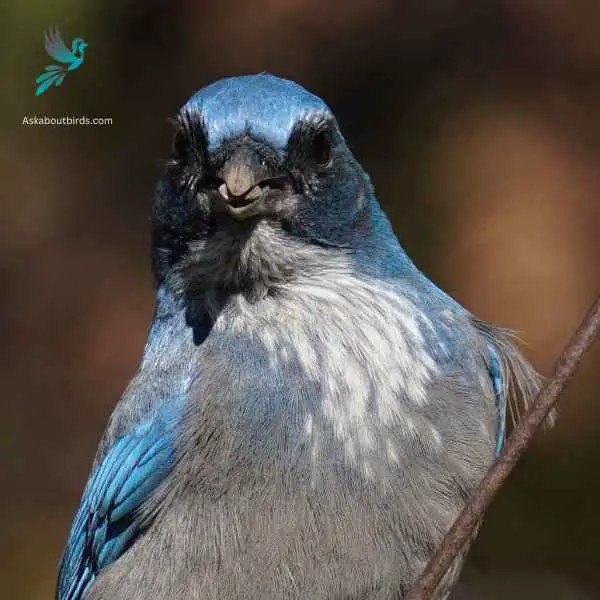

| Feature | Measurement |
|---|---|
| Scientific Name | Gymnorhinus cyanocephalus |
| Length | 9-11 in |
| Wingspan | 18 in |
| Weight | 90-120 g |
The Pinyon Jay is a small, stout bird found in the western United States and Mexico. It has a distinctive blue-gray coloration with a black head and neck. The bird is well adapted to living in dry, arid habitats with sparse vegetation and can often be found in pinyon pine and juniper forests. The Pinyon Jay is known for its communal behavior, living in groups of up to several hundred birds during the non-breeding season. During breeding season, they form monogamous pairs and build nests in juniper trees.
The Pinyon Jay’s diet consists mainly of pinyon pine seeds, but they also eat insects, berries, and other seeds. They have a unique way of storing food for later, using their expandable throat pouch to carry up to 50 seeds at once. The Pinyon Jay is an important seed disperser for pinyon pine and juniper trees, and is a vital part of the ecosystem in its range. However, habitat loss and fragmentation due to human activities, such as logging and oil and gas development, have led to declines in Pinyon Jay populations in recent years.
Mexican Jay


| Feature | Measurement |
|---|---|
| Scientific Name | Aphelocoma wollweberi |
| Length | 12 in |
| Wingspan | 20 in |
| Weight | 120 g |
The Mexican Jay, native to the southwestern United States and Mexico, is a charismatic and intelligent bird known for its vibrant appearance and social behavior. With a striking combination of blue, black, and white feathers, it stands out amidst the arid landscapes it inhabits. Mexican Jays are medium-sized birds with a robust build and a crest on their head, adding to their distinctive charm.
These birds are highly social and often form large flocks that engage in cooperative behaviors such as mobbing predators or foraging together. They have a wide-ranging diet, including seeds, fruits, insects, and even small vertebrates. Mexican Jays are also known for their remarkable vocalizations, which consist of a variety of calls, including raucous squawks and melodious notes.
15 Fun Facts About Blue Jays
Blue Jay Family: Blue jays belong to the Corvidae family, which also includes crows, ravens, and magpies. They are known for their intelligence and social behavior.
Colorful Plumage: The vibrant blue feathers of blue jays are not actually blue. They lack blue pigment and their feathers derive their color from light scattering, known as structural coloration.
Creators of False Alarms: Blue jays are skilled at mimicking the calls of hawks, which often startle other birds into seeking cover. They do this to protect their territory and resources.
Acorn Hoarders: Blue jays have a habit of collecting and caching acorns during the fall. They hide them in various locations, helping to disperse oak trees and inadvertently planting forests.
Mimicking Skills: Blue jays are excellent mimics and can imitate a wide range of sounds, including human voices, the calls of other birds, and even mechanical noises.
Nutritional Specialists: Blue jays have a specialized diet that includes a wide variety of foods. They eat insects, nuts, fruits, seeds, and occasionally small vertebrates like frogs or lizards.
Nesting Habits: Blue jays build their nests using twigs and grass, creating a sturdy cup-shaped structure. They often line the nest with mud, which helps to reinforce its stability.
Territorial Birds: Blue jays fiercely defend their territory from intruders. They engage in aggressive behaviors like dive-bombing and vocal displays to protect their nesting areas and food sources.
Love for Water: Blue jays have a fondness for water and are often seen bathing in shallow pools or bird baths. They splash around and preen their feathers to keep them clean and in good condition.
Mating for Life: Blue jays are monogamous birds and typically mate for life. They form strong bonds with their partners and share responsibilities in raising their young.
Smart and Resourceful: Blue jays are known for their intelligence and problem-solving abilities. They can quickly learn to open nuts by cracking them against hard surfaces or using their beaks.
Vocal Communication: Blue jays are highly vocal birds and use a wide range of calls and vocalizations to communicate with each other. They have specific calls for different situations, including alarm calls, mating calls, and flocking calls.
Winter Migration: While blue jays are generally resident birds, some populations may migrate south during the winter months. They can travel long distances to find suitable food sources.
Fledgling Care: Blue jays take care of their fledglings even after they leave the nest. The parents continue to feed and protect their young until they become independent and can fend for themselves.
Ecological Impact: Blue jays play an important role in seed dispersal. When they hide and forget about the acorns they have cached, these seeds have the potential to grow into new trees, contributing to forest regeneration.
FAQs about birds that look like blue jays
What types of birds resemble Blue Jays?
Blue Jays, with their vibrant blue coloration, are often confused with other birds that exhibit similar hues. Birds that look like Blue Jays include the Steller’s Jay, found in Western North America, and the Mountain Bluebird, both of which have bright blue bodies and blue heads. The Indigo Bunting, another bird with a rich blue plumage, can also be mistaken for a Blue Jay.
What kinds of Jays are there besides Blue Jays?
Aside from the Blue Jay, there are several other jay species. These include the Pinyon Jay, Mexican Jay, and the Scrub Jay species like the California Scrub Jay, Florida Scrub Jay, and Woodhouse’s Scrub Jay. Each of these species is distinguished by unique features, such as the dark blue of Pinyon Jays or the dull blue and black necklace on California Scrub Jays. Island Scrub Jays and Canada Jays are other jays closely related to the Blue Jay.
How do Scrub Jays differ from Blue Jays?
Scrub Jays, including the Florida Scrub Jay, California Scrub Jay, and Woodhouse’s Scrub Jay, are often mistaken for Blue Jays due to their similar blue plumage. However, the blue coloration of Scrub Jays tends to be a lighter blue or sometimes a pale grey, unlike the vibrant blue of Blue Jays. Additionally, while Blue Jays have a blue jay’s crest, Scrub Jays do not. Scrub Jays are more common in the oak woodlands of the western United States, whereas Blue Jays are prevalent in the eastern half of North America.
Which birds can be confused with Blue Jays due to their color?
Apart from the Jays, other birds that resemble Blue Jays due to their blue hue include the Mountain Bluebird and the Indigo Bunting. These birds, with their sky blue to dark blue wings, can easily be mistaken for Blue Jays. Another bird, the Green Jay, despite its bright green coloration, is often confused with Blue Jays in Central and South America due to its size and crest, similar to a blue jay’s.

